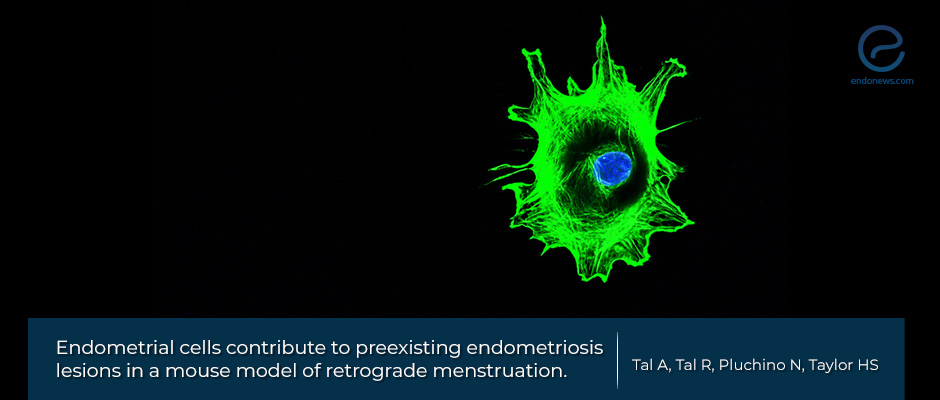Endometrial single cells to contribute preexisting endometriosis.
May 8, 2019
A new study in the mouse model of retrograde menstruation
Key Points
Highlight:
- Dr. Taylor from Yale University found that the individual endometrial cells incorporate into growing endometriosis, reproduce retrograde menstruation and contribute endometriosis expansion, increase the inflammatory burden, expand neovasculature in a mouse model.
Background:
- Endometriosis is an estrogen-dependent inflammatory disease that affects 10% of reproductive-aged women and 20% to 50% of infertile women.
- The retrograde menstruation contributes to implantation of endometrial tissue and formation of endometriotic lesions at ectopic sites, which is established through various rodent and nonhuman primate models by mimicking retrograde menstruation.
- However, the ability of single endometrial cells to participate in endometriosis development has not been evaluated due to their failure to establish macroscopic endometriosis.
Key points:
- Endometriosis was induced in female mice followed by intraperitoneal injection of GFP-labeled single uterine cells.
- Freshly introduced uterine cells could successfully integrate and contribute to various cell populations within the lesion: In total, 13/16 (81.3%) lesions harbored GFP+ cells.
- Immunohistochemistry results have been shown that these GFP+ cells were found in the lesion’s endometrial stroma with some cells integrated into blood vessels’ wall as endothelial cells, but none was in the epithelium.
- These cells also contributed to neo-angiogenesis and inflammatory processes within endometriosis, that is commonly thought of as host-driven phenomena.
Conclusions:
- Dr. Taylor group provide the potential of individual uterine cells to continuously expand lesions and participate in the progression of endometriosis.
- This model of retrograde menstruation may, therefore, be used to study processes involved in the pathophysiology of endometriosis.
Lay Summary
Endometriosis is an estrogen-dependent inflammatory disease. This disease affects approximately 10% of reproductive-aged women and 20% to 50% of infertile women.
Multiple hypotheses have been proposed for the origin of endometriosis. Retrograde menstruation is believed to take part by the implantation of endometrial tissue and formation of endometriotic lesions at ectopic sites, which is established through various rodent and nonhuman primate models in a manner mimicking retrograde menstruation. However, the ability of single endometrial cells to participate in endometriotic processes has not been evaluated due to their failure to establish macroscopic endometriosis.
Here, Dr. Taylor group from the Yale University designed a mouse model to test the capacity of individual uterine cells to become incorporated into a growing endometriosis lesion, seeding endometrial material in a manner reproducing retrograde menstruation. The paper was recently published in the journal "Biology of Reproduction".
Endometriosis was induced in female mice followed by intraperitoneal injection of GFP-labeled single uterine cells. The researchers found that freshly introduced uterine cells can successfully integrate and contribute to various cell populations within the lesion.
In total, 13 out of 16 lesions (81.3%) harbored GFP (+) cells. Immunohistochemistry results have been shown that these GFP (+) cells are in the lesion’s endometrial stroma with some cells integrated into blood vessels’ wall as endothelial cells, but no GFP (+) cells were found in the glandular or luminal epithelium. This finding suggests that these cells also contributed to neo-angiogenesis and inflammatory processes within the lesion, which was commonly thought of as host-driven phenomena.
In conclusion, Dr. Taylor group provide the potential of individual uterine cells to continuously expand lesions and participate in the progression of endometriosis. This model of retrograde menstruation may, therefore, be used to study processes involved in the pathophysiology of endometriosis.
"Our study revealed the potential of the singular endometrial cells to contribute to endometriosis processes of angiogenesis, inflammation, and cell proliferation; and also provides a tool for tracking the fates of these individual cells introduced in a manner reproducing retrograde menstruation, allowing direct comparison of the integration potential of cells. Moreover, in the light of emerging evidence attributing the clonal origin to distinct endometriotic foci, the validated model presented herein may have important potential applications for examining the effect of single-cell genomic alterations on the pathophysiology of the disease", the authors finalized.
Research Source: https://www.ncbi.nlm.nih.gov/pubmed/30869747
Endometriosis Retrograde menstruation Endometrium

